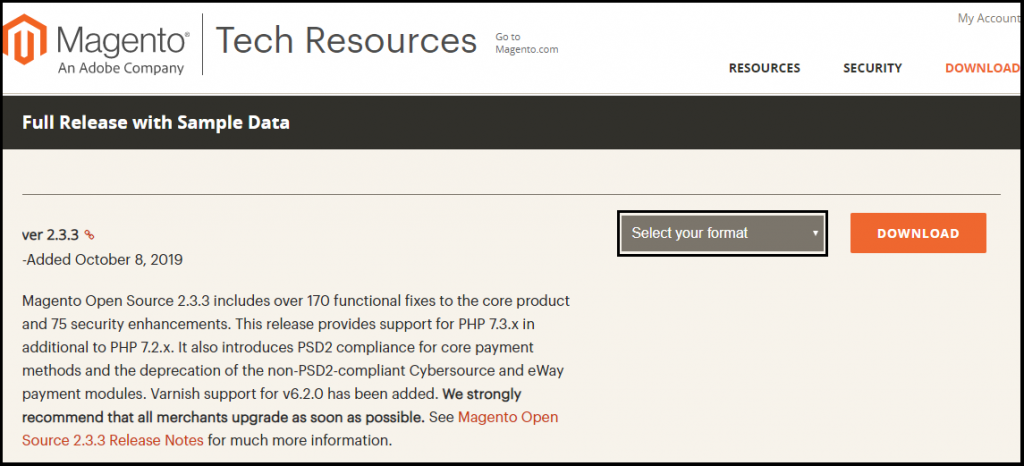
Intended audienceThe audience for this topic is anyone who downloaded a compressed Magento software archive (.zip or.tar). If you’d rather use Composer, go back. PrerequisitesBefore you continue, make sure you’ve done all of the following:. Set up a server that meets our.
Created theGet the Magento softwareThe following table discusses where to get the Magento software. We provide the following downloads:.
Magento Open Source or Magento Commerce software only. Magento Open Source or Magento Commerce software with sample data (designed to help you learn Magento faster)These packages are easy to get and install.
You don’t need to use Composer, all you need to do is to upload a package to your Magento server or hosted platform, unpack it, and run the web-based Setup Wizard.The Web Setup Wizard is being deprecated in Magento 2.3.6 and will be removed in Magento 2.4.0. 1cp /var/www/Magento-CE-2.0.0+Samples.tar.bz2 magento2. Continue with the next section.Extract the software on your serverLog in to your Magento server as, or switch to, the and extract the software package in the web server docroot using one of the following commands: File formatCommand to extract.tar.gztar zxf.zipunzip.tar.bz2tar jxf The Magento software extracts to the directory you created.
After the file has extracted, either delete the Magento archive or move it to another directory. Set pre-installation file system ownership and permissionsThis topic discusses how to set read-write permissions for the web server group before you install the Magento software. This is necessary so the Setup Wizard or command line can write files to the Magento file system.The Web Setup Wizard is being deprecated in Magento 2.3.6 and will be removed in Magento 2.4.0.
In this blog, I will teach you how to install Magento 2 on a Mac for local development. In this instance, we will not being using Vagrant, or any virtual layer. It’s a direct installation. System Requirements. For the web server, we will use MAMP. If you’re not familiar, MAMP is an excellent tool for setting up a local server environment. Log into the Magento server ( via SSH ) as a user, who has permissions to write to the Magento file system. Go to your Magento install dir: cd Magento install dir 3. Enable the module: php bin/magento module:enable UlmodCore UlmodModulename Please replace the 'UlmodModulename' with the current modulename.
Verizon qualcomm 3g cdma. VERIZON QUALCOMM 3G CDMA DRIVER FOR MAC - downloaded 51 times, uploaded on, receiving a 3.67/5 rating by 69 users. USB Driver Installation Guide (DOC, 278 KB) Hydro EDGE C5215 32bit Driver (7.6 MB) Hydro EDGE C5215 64bit Driver (5.9 MB) Hydro ELITE C6750: Verizon Wireless: USB Driver Installation Guide (DOC, 280 KB) Hydro ELITE C6750 32bit Driver (7.2 MB) Hydro ELITE C6750 64bit Driver (4.9 MB) Hydro ICON C6730: Boost Mobile.
After it is removed, you must use the command line to or Magento.The procedure you use is different, depending on whether you use and have one user or if you use a and have two users.If you’re using a Magento version earlier than 2.0.6, see instead. Set permissions for shared hosting (one user)This section discusses how to set pre-installation permissions if you log in to the Magento server as the same user that also runs the web server.
This type of setup is common in shared hosting environments. Complete the following tasks in the order shown:.About the shared groupTo enable the web server to write files and directories in the Magento file system but to also maintain ownership by the Magento file system owner, both users must be in the same group. This is necessary so both users can share access to Magento files (including files created using the Magento Admin or other web-based utilities).This section discusses how to create a new Magento file system owner and put that user in the web server’s group. You can use an existing user account if you wish; we recommend the user have a strong password for security reasons.Skip to if you plan on using an existing user account.
Step 1: Create the Magento file system owner and give the user a strong passwordThis section discusses how to create the Magento file system owner. (Magento file system owner is another term for the command-line user.)To create a user on CentOS or Ubuntu, enter the following command as a user with root privileges. 1grep -Ei '^user ^group' /etc/httpd/conf/httpd.confTypically, the user and group name are both apache.

Ubuntu: ps aux grep apache to find the apache user, then groups to find the group.Typically, the username and the group name are both www-data. Step 3: Put the Magento file system owner in the web server’s groupTo put the Magento file system owner in the web server’s primary group (assuming the typical Apache group name for CentOS and Ubuntu), enter the following command as a user with root privileges:. CentOS: usermod -a -G apache. Ubuntu: usermod -a -G www-data The -a -G options are important because they add apache or www-data as a secondary group to the user account, which preserves the user’s primary group. Adding a secondary group to a user account helps to ensure members of a shared group only have access to certain files.For example, to add the user magentouser to the apache primary group on CentOS. 1magentouser: magentouser apacheTypically, the username and primary group name are the same.To complete the task, restart the web server:.
Ubuntu: service apache2 restart. CentOS: service httpd restartStep 4: Get the Magento softwareIf you haven’t done so already, get the Magento software in one of the following ways:.Step 5: Set ownership and permissions for the shared groupTo set ownership and permissions before you install the Magento software:. Log in to your Magento server as, or switch to, the Magento file system owner.Enter the following commands in the order shown.